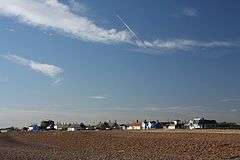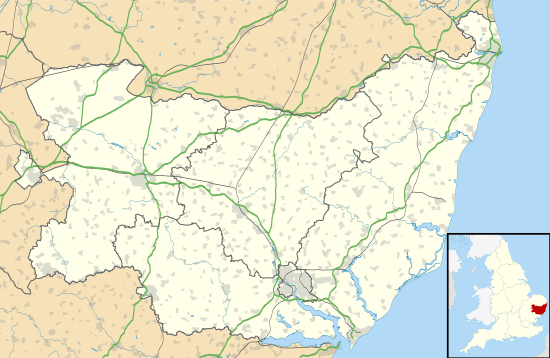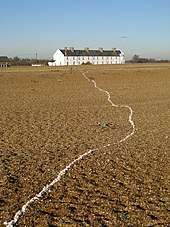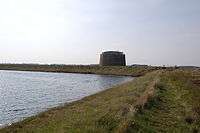Shingle Street
Shingle Street is a small coastal hamlet in Suffolk, England, at the mouth of Orford Ness, situated between Orford and Bawdsey. Part of the coast is also known as Hollesley Bay; HM Young Offender Institution, Hollesley Bay Colony, is nearby.
| Shingle Street | |
|---|---|
 Shingle Street in January 2008. | |
 Shingle Street Location within Suffolk | |
| Shire county | |
| Region | |
| Country | England |
| Sovereign state | United Kingdom |
| Police | Suffolk |
| Fire | Suffolk |
| Ambulance | East of England |
 |
| Map of Shingle Street and Orford Ness, Suffolk.[1] |
Shingle Street was originally a home for fishermen and river pilots for the River Ore. Early in the 19th century a Martello tower was built, which was later a home for coastguards. Many of the original buildings date from this period, although several buildings were destroyed during World War II, including the Lifeboat Inn, the hamlet's only pub. A report from October 2004 suggests that Shingle Street is at risk from the sea and could disappear within 20 years if sea defences are not erected.[2]
Shingle Street was the inspiration of the Thomas Dolby song "Cloudburst at Shingle Street", from the album The Golden Age of Wireless.
World War II
After World War II many strange happenings were reported to have taken place at Shingle Street, including a failed German invasion.[3][4][5] Since the civilian population had been evacuated in May 1940, there were no eyewitness reports, although official documents remained classified until questions in the House of Commons led to their early release in 1993.[6] These papers disclosed no German landing. In fact rumours of a failed invasion on the South and East Coasts were commonplace in September 1940 and helped to boost morale. Author James Hayward has proposed that these rumours, which were widely reported in the American press, were a successful example of black propaganda with an aim of ensuring American co-operation and securing lend lease resources by showing that the United Kingdom was capable of successfully resisting the German Army.[7]
The Shingle Street Shell Line

In 2005 stonecutter Lida Cardozo Kindersley and her childhood friend Els Bottema started to arrange a line of shells on the beach, beginning as a way of coping with their shared experience of cancer treatment. After regular visits to add to the line by 2018 it stretched for more than 275m and was made up of 20,000 individual whelk shells.[8] A short documentary film about the work, entitled 'C Shells', was released in 2017, followed by a book 'The Shingle Street Shell Line' by Bottema and Kindersley in 2018.[9][10][11]
- Views of Shingle Street
 Coastguard cottages, Shingle Street
Coastguard cottages, Shingle Street The Martello tower
The Martello tower Percolation lagoon at Shingle Street
Percolation lagoon at Shingle Street
References
- "Orfordness Visitor Map" (PDF). National Trust. 2018. Retrieved 19 November 2018.
- "Shingle Street". Archived from the original on 24 December 2007.
- Hayward, James (28 May 2001). The Bodies on the Beach: Sealion, Shingle Street and the Burning Sea Myth of 1940. CD41 Publishing. p. 18. ISBN 0-9540549-0-3.
- "1940: The Secret War at Shingle Street". Ronald Ashford. 7 November 2007. Retrieved 23 September 2007.
- Hayward, James (2 October 2002). "The Bodies on the Beach". BBC News. Retrieved 23 September 2007.
- Hansard Debates. House of Commons. 19 February 1993.
- Hayward, James (2002). Shingle Street. CD41 Publishing. ISBN 0-9540549-1-1.
- "Shingle Street shell line inspired by friends' cancer treatment". www.bbc.co.uk. 17 March 2018. Retrieved 2 June 2019.
- "C Shells". outhousefilmworks.uk. Retrieved 2 June 2019.
- "Suffolk Shorts: East Anglian Stories - First Light Festival". firstlightlowestoft.com. Retrieved 25 August 2019.
- Bottema, Els; Lopes Cardozo, Lida (1 March 2018). The Shingle Street Shell Line. Cardozo Kindersley Editions. ISBN 978-1874426226.
Further reading
- Johnson, Derek E (1992). East Anglia at War 1939-1945. Jarrold Publishing. ISBN 978-0-7117-0598-2.CS1 maint: ref=harv (link)
External links
